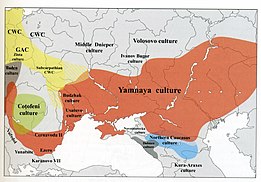Cernavodă culture
| Geographical range | Bulgaria, Romania, Serbia |
|---|---|
| Period | Chalcolithic |
| Dates | c. 4000 BC – 3200 BC |
| Preceded by | Serednii Stih culture, Suvorove culture, Karanovo culture, Gumelnița culture, Varna culture |
| Followed by | Coțofeni culture, Baden culture, Usatove culture, Yamnaya culture, Ezero culture |

The Cernavodă culture, ca. 4000–3200, is a late Copper Age archaeological culture distributed along the lower Eastern Bug River and Danube and along the coast of the Black Sea and somewhat inland, generally in present-day Bulgaria and Romania. It is named after the Romanian town of Cernavodă (Bulgarian černa vodá (черна водá in cyrillic) means 'black water').
It is a successor to and occupies much the same area as the earlier Karanovo culture and Gumelnița culture, for which a destruction horizon seems to be evident. It is part of the "Balkan-Danubian complex" that stretches up the entire length of the river and into northern Germany via the Elbe and the Baden culture; its northeastern portion is thought by some scholars to be ancestral to the Usatove culture.
It is characterized by defensive hilltop settlements. The pottery shares traits with that found further east, in the Serednii Stih culture on the south-west Eurasian steppe;[citation needed] burials similarly bear a resemblance to those further east.
It has been theorized that Cernavoda culture, together with the Serednii Stih (Sredny Stog (Средний Стог) in Russian - middle (hay)stack) culture, was the source of Anatolian languages and introduced them to Anatolia through the Balkans after Anatolian split from the Proto-Indo-European language, which some linguists and archaeologists place in the area of the Serednii Stih culture.[1][2][3]
Gallery
[edit]-
Metal, bone and ceramic artefacts
See also
[edit]- Bronze Age in Romania
- Coțofeni culture
- Basarabi culture
- Ottomány culture
- Pecica culture
- Wietenberg culture
- Hamangia culture
- Prehistory of Transylvania
- Prehistoric Romania
Notes
[edit]- ^ Kroonen, Guus; Jakob, Anthony; Palmér, Axel I.; Sluis, Paulus van; Wigman, Andrew (12 October 2022). "Indo-European cereal terminology suggests a Northwest Pontic homeland for the core Indo-European languages". PLOS ONE. 17 (10): e0275744. Bibcode:2022PLoSO..1775744K. doi:10.1371/journal.pone.0275744. ISSN 1932-6203. PMC 9555676. PMID 36223379.
- ^ Краткая история освоения индоевропейцами Европы (in Russian)
- ^ Anthony, David. The Horse, the Wheel, and Language. OCLC 1102387902.
References
[edit]- Anthony, David W. (2007). The Horse, the Wheel, and Language: How Bronze-Age Riders from the Eurasian Steppes Shaped the Modern World. Princeton University Press. ISBN 978-0691058870.
- J. P. Mallory, "Cernavoda Culture", Encyclopedia of Indo-European Culture, Fitzroy Dearborn, 1997.

